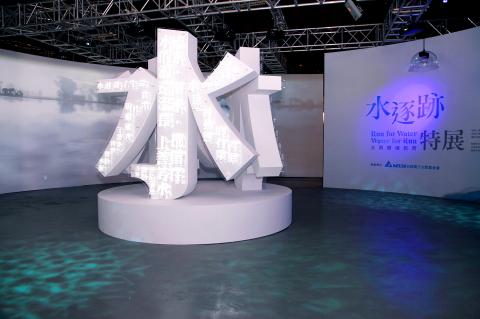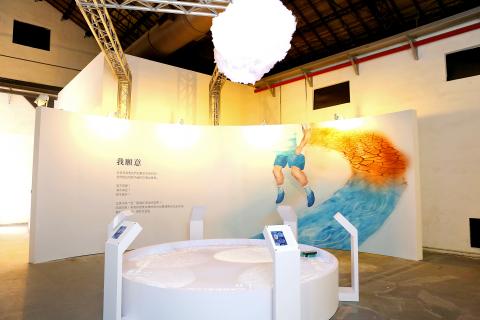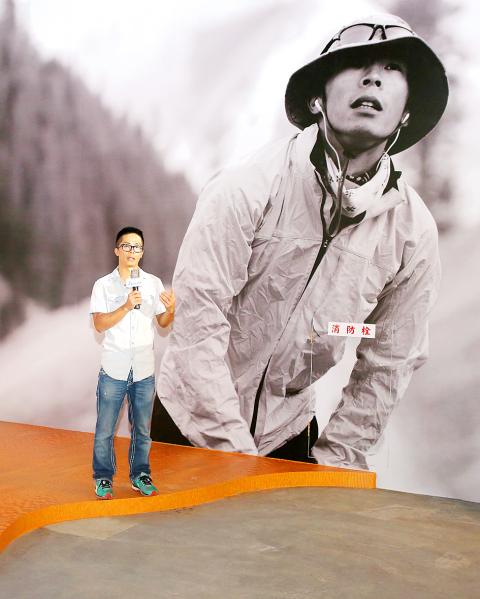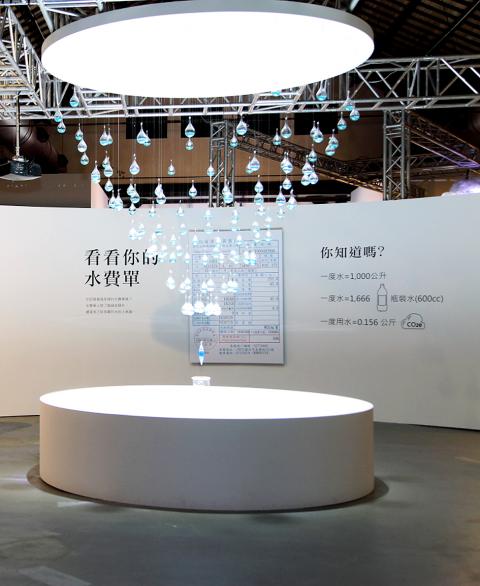The Ice Bucket Challenge poses a conundrum. Though it was for a good cause, it was a waste of drinking water. US actor Matt Damon highlighted this when he substituted toilet water for drinking water as did Taiwanese-Japanese actor Takeshi Kaneshiro (金城武), who opted for water from his dehumidifier. Water scarcity is one of the concerns at Run for Water, Water for Run (水逐跡特展), a must-see exhibition currently on view at the Songshan Cultural and Creative Park (松山文創園區).
Organized by Delta Electronics Foundation (台達電子文教基金會), which has dedicated itself to environmental research and education since its inception in 1990, the exhibition aims to raise public awareness of the global water crisis as well as sustainability and efficiency of water use.
Explaining scientific facts through an audio-visual presentation in a way people will understand was the biggest challenge organizing the exhibition says Guo Shan-shan (郭珊珊), executive director of the foundation.

Photo courtesy of Delta Electronics Foundation
“Promoting environmental education is much like advocating a green lifestyle. People need to understand and accept it before taking action ... We address the issue through people’s relations with water, hoping that visitors can understand the effects of water scarcity and be willing to change their habits,” Guo told the Taipei Times.
The water footprint concept is expressed using simple examples. If you drink a cup of coffee every day, for example, yearly water consumption is equal to the amount of water carried by 27 fire trucks.
Wim Chang (張楊乾), the foundation’s deputy executive director who has practiced water conservation, shares his experiences with a nifty device he uses at home. It is designed to recycle water from his washing machine, which when combined with other water saving measures reduces his water consumption by 88 percent when compared to the average household in Taiwan.

Photo courtesy of Delta Electronics Foundation
GLOBAL MATTERS
With technical support from Delta Electronics Inc, the technically polished multi-media exhibition is divided into several sections. Upon entering the exhibition, visitors are greeted by several short films provided by Water.org, a non-profit organization co-founded by Damon and Gary White that is dedicated to tackling water and sanitation problems in developing countries.
Highlighting the lack of clean water for millions of people around the world, the films reveal some shocking facts. For example, in rural Ethiopia, villagers, usually women and children, walk four to eight hours to gather water, often from shallow ponds they share with animals. Many die from preventable water-related diseases.

Photo courtesy of Delta Electronics Foundation
Across the room, one work shows that in Tuvalu, an island nation that is likely to be the world’s first casualty of climate change if sea levels continue to rise, locals have built mangrove plantations designed to help protect the coastline from erosion. Composed of photographs and explanatory notes, the display is based on the first-hand experience of one of the foundation’s employees, who has done volunteer work in Tuvalu for two years.
Guo says the water crisis that is occuring in most parts of the world is closely related to global warming, a key issue addressed in the fifth assessment report from the UN’s Intergovernmental Panel on Climate Change (IPCC). The report has been translated into Chinese and made available for public use by the foundation.
LOCAL STORIES

Photo courtesy of Delta Electronics Foundation
One section focuses on water-related issues in Taiwan. The past and present of Chianan Irrigation System (嘉南大圳), built by the Japanese colonial government in the 1920s, is told through stories by a local octogenarian, who worked on the canal decades ago.
The exhibition team filmed a documentary in Greater Kaohsiung’s Namasiya Township (那瑪夏), devastated by Typhoon Morakot in 2009. It shows how villagers from an indigenous community have to trek into a mountain to obtain spring water because they lack the infrastructure for providing drinking water.
KEEP RUNNING
Another display introduces the expeditions ultramarathon runner Kevin Lin (林義傑) took to the Sahara Desert in 2006, along the Silk Road in 2011 and the Gobi Desert last year.
A clean water advocate, Lin says his journeys have opened his eyes to the hardships caused by water shortage.
A series of photographs show a little boy Lin encountered while running through the Sahara Desert. Alone, the boy was waiting for the return of his parents, who had set out on a two-day trek to get water.
During the exhibition period, lectures will be given every Saturday and Sunday from 3pm to 4pm. Today’s invited speaker will be Ke Chin-yuan (柯金源), an experienced environmental documentary filmmaker, while Taiwanese poet Wu Sheng (吳晟) will take the floor on Saturday.
For non-Chinese speakers, exhibition handouts that explain the content of each section are available in English. A 40-minute English guided tour is provided every Saturday at 1:30pm and 4pm. Other weekend time slots can also be arranged by making requests online. More information can be found at the exhibition’s bilingual Web site: waterforrun.blogspot.tw.

April 14 to April 20 In March 1947, Sising Katadrepan urged the government to drop the “high mountain people” (高山族) designation for Indigenous Taiwanese and refer to them as “Taiwan people” (台灣族). He considered the term derogatory, arguing that it made them sound like animals. The Taiwan Provincial Government agreed to stop using the term, stating that Indigenous Taiwanese suffered all sorts of discrimination and oppression under the Japanese and were forced to live in the mountains as outsiders to society. Now, under the new regime, they would be seen as equals, thus they should be henceforth

Last week, the the National Immigration Agency (NIA) told the legislature that more than 10,000 naturalized Taiwanese citizens from the People’s Republic of China (PRC) risked having their citizenship revoked if they failed to provide proof that they had renounced their Chinese household registration within the next three months. Renunciation is required under the Act Governing Relations Between the People of the Taiwan Area and the Mainland Area (臺灣地區與大陸地區人民關係條例), as amended in 2004, though it was only a legal requirement after 2000. Prior to that, it had been only an administrative requirement since the Nationality Act (國籍法) was established in

With over 80 works on display, this is Louise Bourgeois’ first solo show in Taiwan. Visitors are invited to traverse her world of love and hate, vengeance and acceptance, trauma and reconciliation. Dominating the entrance, the nine-foot-tall Crouching Spider (2003) greets visitors. The creature looms behind the glass facade, symbolic protector and gatekeeper to the intimate journey ahead. Bourgeois, best known for her giant spider sculptures, is one of the most influential artist of the twentieth century. Blending vulnerability and defiance through themes of sexuality, trauma and identity, her work reshaped the landscape of contemporary art with fearless honesty. “People are influenced by

The remains of this Japanese-era trail designed to protect the camphor industry make for a scenic day-hike, a fascinating overnight hike or a challenging multi-day adventure Maolin District (茂林) in Kaohsiung is well known for beautiful roadside scenery, waterfalls, the annual butterfly migration and indigenous culture. A lesser known but worthwhile destination here lies along the very top of the valley: the Liugui Security Path (六龜警備道). This relic of the Japanese era once isolated the Maolin valley from the outside world but now serves to draw tourists in. The path originally ran for about 50km, but not all of this trail is still easily walkable. The nicest section for a simple day hike is the heavily trafficked southern section above Maolin and Wanshan (萬山) villages. Remains of